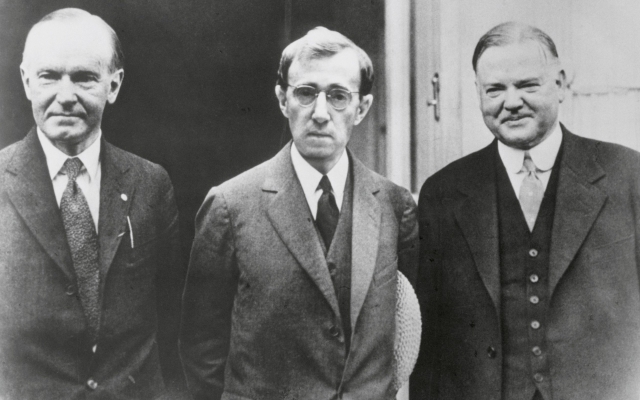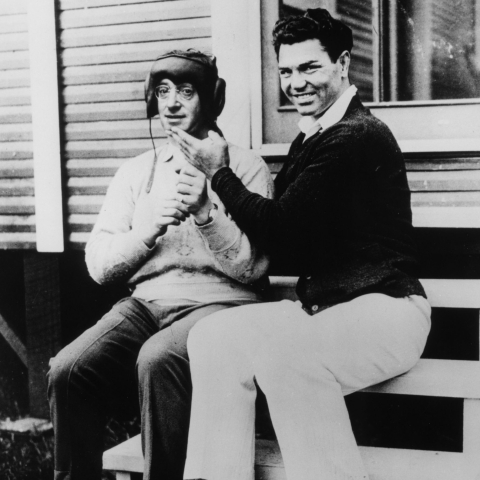 Confluence: Woody Allen in Zelig Photo: Everett Collection Inc/Alamy Stock Photo
Confluence: Woody Allen in Zelig Photo: Everett Collection Inc/Alamy Stock Photo
Which 40-year-old Woody Allen film still inspires psychiatric articles? The answer is Zelig, Allen's 1983 jeu d'esprit about a funny little guy from the jazz age who manages to fit in perfectly with any company without even trying.
Being a mostly black-and-white historical rarity that is also a mockumentary — making it a sort of complement to Allen's early scherzo Take the Money and Run (1969) — Zelig still manages to stand apart. «Where's Wally?» the arrogant expectation of Allen appearing in the most unexpected places, including even a Nazi rally, is very funny.
Like most of his work of the early 1980s, it was only a modest success at the time, but persisted in culture, not least because of «Selig Syndrome,» a term psychiatrists later appropriated for what is also called environmental dependency syndrome. «Selig-like» has become part of the lexicon, understandable even to people who have never seen it.
Leonard Zelig, played by Allen—mostly only in silent film footage or snippets and with lots of hilariously tongue-in-cheek expressions—is a prime example of this disorder. Place him between two obese men and he will appear with a huge paunch; in a jazz band in a Chicago bar, this «human chameleon» becomes a black trumpeter, and so on.
We see Zelig, a nondescript extra in his own life, transform 44 times throughout the film, accurately mimicking the occupations, attitudes, ethnicities, and phenotypes of everyone he comes into contact with. It's hard to try to psychoanalyze him the way psychiatrist Dr. Eudora Fletcher (intentionally Mia Farrow) tries to do, because he is completely convinced that he is a professional and she should be on the couch.
Zelig's intimate vanity is that we never see him in the middle of a metamorphosis or transition from one personality to another—each personality is a snapshot. So, he was glimpsed, say, at Yankee Stadium, standing inexplicably behind Babe Ruth in the batters circle, though no one would recognize him.
Revealing these effects using newsreel footage was no easy task for Allen, his editor Susan Morse, and cinematographer Gordon Willis, who made Annie Hall and Manhattan and The Godfather I and II, but somehow got their first Oscar nomination for it.
Regardless of those previous snubs, this particular quote was well deserved. Willis had to find vintage lenses and lights to mimic the clips they wanted Allen in, and then use matte devices to simulate grain, dirt, and shimmer. The approach was trial and error, and they had to shoot a lot of footage to get the perfect match — 75 hours, according to Morse, with 30 hours of footage as reference. (The film took so long to assemble that Allen finished the other two during production.)
 Woody Allen as Zelig with U.S. Presidents Calvin Coolidge and Herbert Hoover. Photo: Bettmann
Woody Allen as Zelig with U.S. Presidents Calvin Coolidge and Herbert Hoover. Photo: Bettmann
When sound was needed, they used microphones made in 1928, and several «home movie» scenes were shot at 16 or 18 frames per second to mimic the look of the hand-operated era. There was still a lot of work to be done in post-processing — adding a grainy animated shadow, for example, behind Allen in a baseball diamond.
The results of all this technical wizardry are impressive: ten years before Industrial Light and Magic put Tom Hanks next to JFK, Nixon, and so on in the obviously indebted Forrest Gump (1994). But such scenes in Zelig are infinitely more charming, because nothing in them screams «special effect» either. The fact that they are mostly silent also makes them a lot funnier.
Allen's other coup was that he framed the story with contemporary interviews in color, enticing a group of well-known cultural commentators to become his talking heads—amusingly ranting about the real significance of this fictional guy. Thus, people like Susan Sontag, Saul Bellow, and the Austrian psychologist Bruno Bettelheim seem as good-natured as they are, saying exactly what they would say. In a way, they are the forerunners of those experts who are so good at Cunk on Earth.
 Woody Allen as Zelig with heavyweight champion Jack Dempsey. Photo: Hulton Archive/Getty Images
Woody Allen as Zelig with heavyweight champion Jack Dempsey. Photo: Hulton Archive/Getty Images
The pseudo-documentary format was far from new — even for Allen himself — although Zelig had just added «This is Spinal Tap» (1984) to the post, popularizing it. Even some evaluative reviews at the time gave the impression that the film was just a joke made with brilliant technical know-how, which disappointed Allen, who later said that it was Zelig's content, not technique or jokes, that made him do it.
«I wanted to comment on […] the particular danger of giving up your true self in an attempt to please, not create problems, fit in, and where it leads in life,» he explained in a 1994 interview. Selig becomes an essay not only about a slippery identity, but also about Jewish identity: there is definitely a reason why the action takes place at the turn of the 1930s, when Leonard is the victim of anti-Semitic intimidation as a child.
The smartest and by far the most difficult episode to achieve — the Nazi rally — Allen was noticed in the party ranks behind the ranting Hitler on the podium, he waved frantically, to get Farrow's attention. . It is both the film's comical pinnacle and its most poignant statement about the dangers of assimilation: the repressive and even contagious nature of the conformism upon which the Third Reich depended.

There is also a way to read Zelig as Allen's self-criticism about how eagerly he always copied his intellectual heroes, such Neil, Fellini, Graucho. Marx and J. D. Salinger. His reliance on these heavyweight influences can be seen as the same condition that strikes Zelig: where does that leave Allen politically and creatively? Is he just a dangling windsock, an empty man?
Zelig only gets his 15 minutes of fame from borrowed stats, not from anything he personally brings to the table. It instantly became a meme, sparking a craze for dancing called the chameleon. He's even been «cancelled» as a viable celebrity — Allen should be able to tell in hindsight — when various women come forward claiming he's fathered their children and then, obliviously, walks off. He makes a daring, Lindbergh-like escape from Europe, mimicking the skills of an aviatrix, only to redeem himself by winning a ticker tape parade in New York (as Charles Lindbergh did before urging Congress to negotiate with Hitler).
It's hard to be the hero of history, being completely devoid of personal convictions, which is part of Zelig's joke, but also Allen's comment (with hints of Gatsby) on Mohr al bankruptcy of the 20th century. It hardly seems less appropriate now: if Leonard Zelig lived to see 2023, he would be quite suitable for a serial retweet with a random blue tick.




































































Свежие комментарии